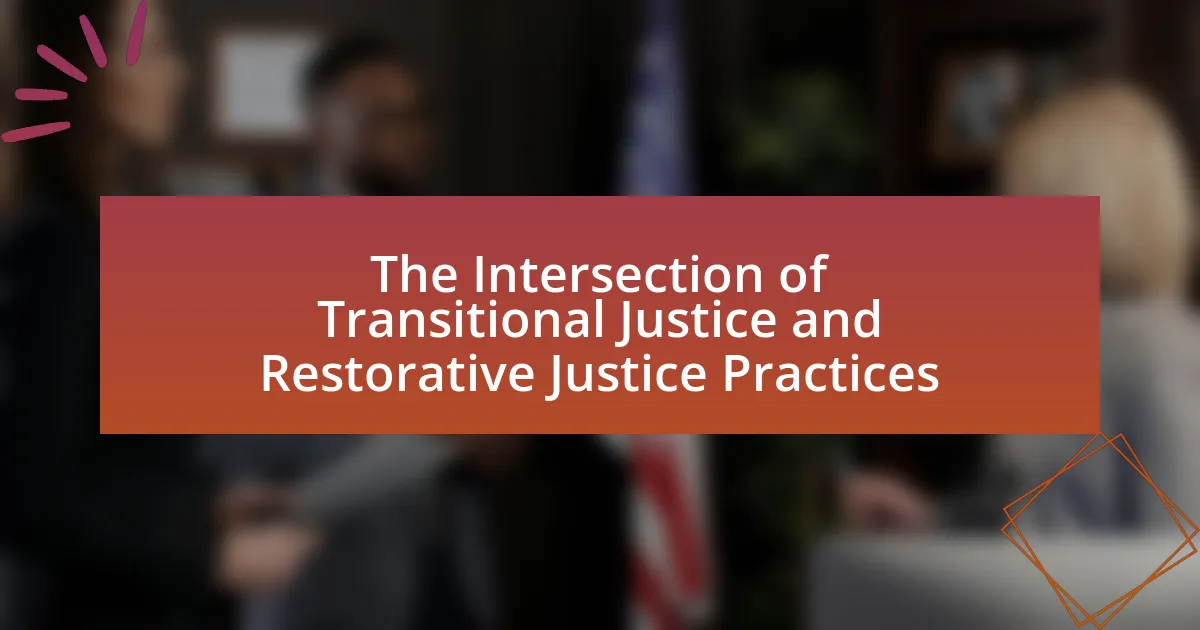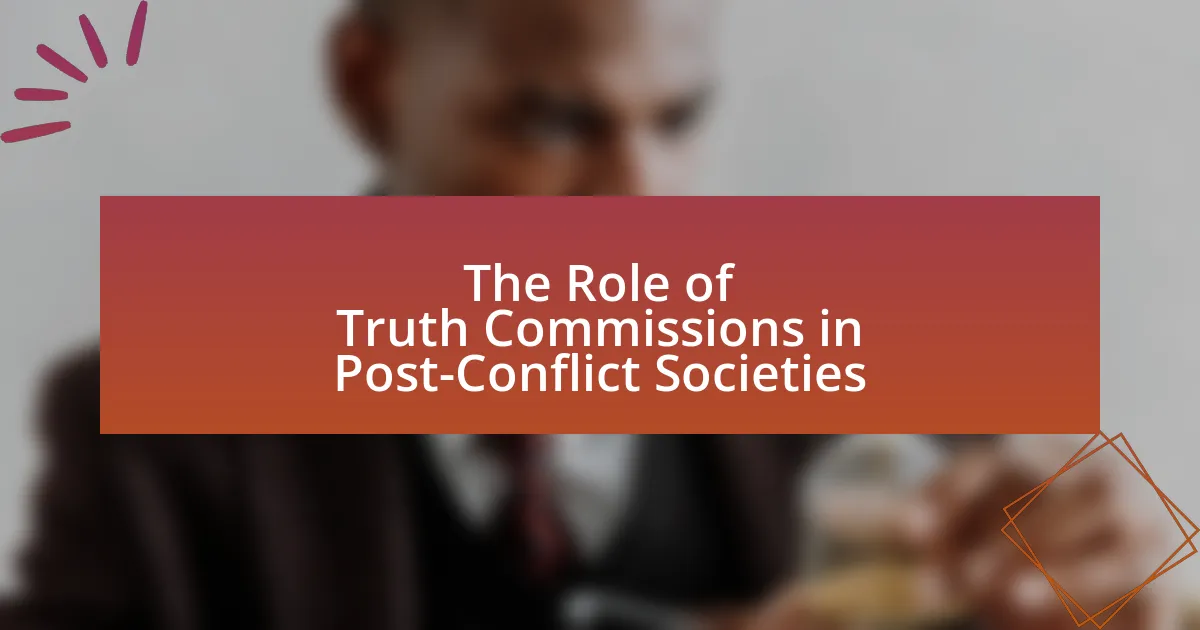Gender considerations in truth and reconciliation processes are essential for recognizing and addressing the unique experiences and needs of different genders, particularly women and marginalized groups, following conflict or systemic injustice. The article outlines the importance of inclusive reconciliation frameworks that incorporate gender dynamics, highlighting how women’s participation can lead to more sustainable peace outcomes. It discusses historical contexts that shape gender considerations, key components of gender-sensitive approaches, and the roles women play in truth and reconciliation commissions. Additionally, the article examines cultural factors, challenges, and best practices for integrating gender perspectives into reconciliation efforts, emphasizing the need for collaboration and education to foster gender awareness.
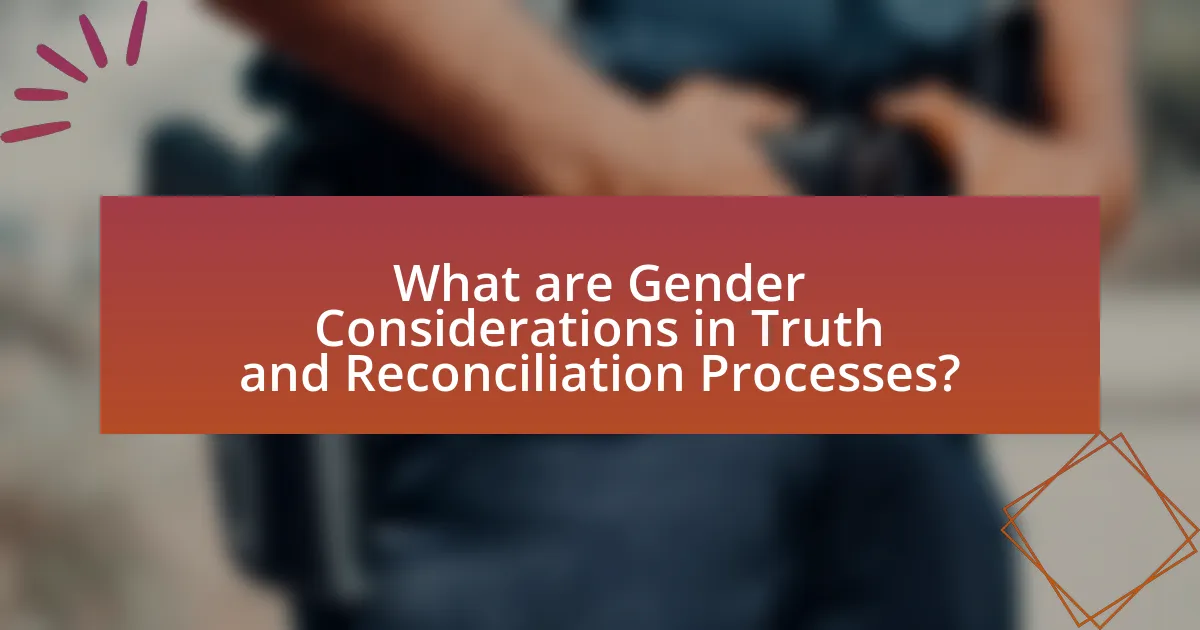
What are Gender Considerations in Truth and Reconciliation Processes?
Gender considerations in truth and reconciliation processes involve recognizing and addressing the distinct experiences and needs of different genders, particularly women and marginalized groups, in the aftermath of conflict or systemic injustice. These considerations are crucial because women often face unique forms of violence and discrimination during conflicts, which can be overlooked in traditional reconciliation frameworks. For instance, the United Nations Security Council Resolution 1325 emphasizes the importance of women’s participation in peace processes and highlights the need for gender-sensitive approaches to ensure that women’s voices are included in decision-making. Research shows that inclusive reconciliation processes that consider gender dynamics lead to more sustainable peace outcomes, as they address the root causes of conflict and promote social cohesion.
Why are gender considerations important in truth and reconciliation processes?
Gender considerations are important in truth and reconciliation processes because they ensure that the experiences and needs of all genders are recognized and addressed. This inclusivity helps to create a more comprehensive understanding of the impacts of conflict and injustice, as women, men, and non-binary individuals often experience violence and discrimination differently. For instance, research by the United Nations indicates that women are disproportionately affected by conflict-related sexual violence, which necessitates specific attention in reconciliation efforts to promote healing and justice. Additionally, incorporating gender perspectives can enhance the legitimacy and effectiveness of reconciliation processes, as diverse voices contribute to more equitable outcomes and foster social cohesion.
How do gender dynamics influence the outcomes of reconciliation efforts?
Gender dynamics significantly influence the outcomes of reconciliation efforts by shaping the participation and representation of different genders in the process. Research indicates that when women are actively involved in reconciliation initiatives, the likelihood of achieving sustainable peace increases. For instance, a study by the United Nations found that peace agreements are 35% more likely to last for at least 15 years when women participate in the negotiation process. Additionally, gender-sensitive approaches address the specific needs and experiences of all genders, fostering a more inclusive environment that can lead to more effective conflict resolution and healing. This evidence underscores the critical role that gender dynamics play in determining the success of reconciliation efforts.
What historical contexts shape gender considerations in these processes?
Historical contexts that shape gender considerations in truth and reconciliation processes include colonial histories, war and conflict, and systemic discrimination. Colonial histories often result in the marginalization of women and gender minorities, influencing their representation in reconciliation efforts. For instance, in post-apartheid South Africa, the Truth and Reconciliation Commission acknowledged the specific experiences of women under apartheid, highlighting how gendered violence was a tool of oppression. Additionally, conflicts such as the Rwandan Genocide have shown that women often bear the brunt of violence, leading to a need for gender-sensitive approaches in reconciliation. Systemic discrimination, as seen in many societies, further complicates gender dynamics, necessitating tailored strategies to address the unique challenges faced by different genders in the aftermath of conflict.
What are the key components of gender considerations in reconciliation?
The key components of gender considerations in reconciliation include the recognition of diverse experiences of gendered violence, the inclusion of women’s voices in decision-making processes, and the promotion of gender equality in post-conflict recovery. Recognizing diverse experiences is crucial as women and men often face different impacts during conflicts, with women frequently experiencing sexual violence and displacement. Inclusion of women’s voices ensures that reconciliation processes address their specific needs and perspectives, which is supported by evidence showing that women’s participation leads to more sustainable peace outcomes. Promoting gender equality in recovery efforts is essential for rebuilding societies, as studies indicate that gender-equitable societies are more resilient and stable.
What roles do women play in truth and reconciliation commissions?
Women play crucial roles in truth and reconciliation commissions (TRCs) as advocates, participants, and leaders. Their involvement often includes providing testimonies that highlight gender-specific experiences of violence and discrimination, which are essential for a comprehensive understanding of the conflict’s impact. Research indicates that when women are included in TRCs, the processes are more likely to address issues such as sexual violence and the needs of marginalized groups, leading to more equitable outcomes. For instance, the South African TRC included women’s testimonies that brought attention to gender-based violence, influencing policy changes and societal awareness. Additionally, women often serve as commissioners or in advisory roles, contributing to the design and implementation of TRC processes, which enhances the representation of women’s perspectives in reconciliation efforts.
How does the inclusion of diverse gender identities impact reconciliation?
The inclusion of diverse gender identities significantly enhances reconciliation by fostering a more comprehensive understanding of the experiences and needs of all affected individuals. This inclusivity ensures that the reconciliation process addresses the unique challenges faced by marginalized gender identities, which can lead to more equitable outcomes. For instance, research indicates that when diverse gender perspectives are integrated into reconciliation frameworks, it promotes healing and trust among communities, as seen in the Truth and Reconciliation Commission of Canada, which acknowledged the specific impacts of colonialism on Indigenous women and gender-diverse individuals. This recognition not only validates their experiences but also encourages broader societal acceptance and support, ultimately contributing to a more effective and holistic reconciliation process.
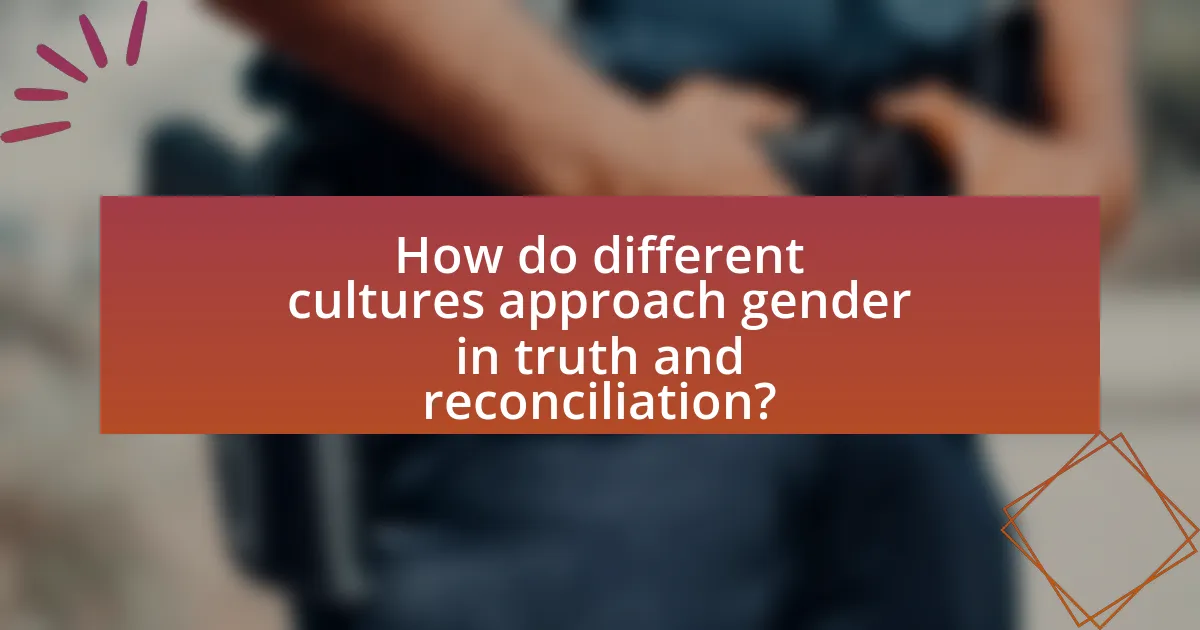
How do different cultures approach gender in truth and reconciliation?
Different cultures approach gender in truth and reconciliation by integrating gender-specific perspectives and addressing the unique experiences of women and marginalized genders during conflict and its aftermath. For instance, in many Indigenous cultures, women’s roles as caregivers and community leaders are emphasized, leading to their active participation in reconciliation processes. In contrast, some Western approaches may focus more on legal frameworks and formal apologies, often overlooking the nuanced gender dynamics at play. Research indicates that inclusive reconciliation processes that consider gender can lead to more sustainable peace outcomes, as seen in post-apartheid South Africa, where women’s voices were crucial in shaping the Truth and Reconciliation Commission’s agenda.
What cultural factors influence gender considerations in reconciliation processes?
Cultural factors such as traditional gender roles, societal norms, and historical context significantly influence gender considerations in reconciliation processes. Traditional gender roles often dictate the expectations and responsibilities assigned to men and women, impacting their participation and representation in reconciliation efforts. Societal norms can either empower or marginalize women, affecting their ability to voice their experiences and needs during reconciliation. Historical context, including past injustices and conflicts, shapes the collective memory and narratives surrounding gender, which can either facilitate or hinder inclusive dialogue. For instance, in post-conflict societies, women’s roles in peacebuilding have been recognized as crucial, yet they often face barriers due to entrenched patriarchal structures. These cultural factors collectively determine how gender dynamics are navigated in reconciliation processes, influencing outcomes and the effectiveness of healing initiatives.
How do traditional gender roles affect participation in reconciliation efforts?
Traditional gender roles significantly limit participation in reconciliation efforts by reinforcing stereotypes that assign caregiving and emotional labor primarily to women, while positioning men as decision-makers and leaders. This division often results in women’s voices being marginalized in peacebuilding discussions, as evidenced by the United Nations Security Council Resolution 1325, which highlights the need for women’s participation in peace processes. Furthermore, studies show that societies with rigid gender norms tend to experience lower levels of female involvement in reconciliation initiatives, thereby undermining the effectiveness of these efforts. For instance, research by the International Peace Institute indicates that inclusive reconciliation processes that actively engage women lead to more sustainable peace outcomes.
What examples exist of culturally specific approaches to gender in reconciliation?
Culturally specific approaches to gender in reconciliation include the use of traditional practices and community involvement to address gender-based issues. For instance, in Rwanda, the Gacaca courts incorporated women’s voices and experiences in the reconciliation process, allowing female survivors of the genocide to share their stories and seek justice. This approach recognized the unique trauma faced by women and aimed to empower them within the community. Similarly, in South Africa, the Truth and Reconciliation Commission included gender-sensitive hearings that focused on the experiences of women during apartheid, highlighting sexual violence and discrimination. These examples demonstrate how culturally tailored methods can effectively address gender dynamics in reconciliation efforts.
How can gender-sensitive approaches enhance reconciliation outcomes?
Gender-sensitive approaches can enhance reconciliation outcomes by ensuring that the unique experiences and needs of all genders are recognized and addressed in the reconciliation process. These approaches facilitate inclusive dialogue, which can lead to more comprehensive understanding and healing among affected communities. For instance, research by the United Nations indicates that when women are included in peace processes, the likelihood of lasting peace increases by 35%. This demonstrates that gender-sensitive strategies not only promote equality but also contribute to more effective and sustainable reconciliation efforts.
What strategies can be employed to ensure gender inclusivity in reconciliation processes?
To ensure gender inclusivity in reconciliation processes, strategies must include the active participation of women in decision-making roles, the integration of gender perspectives in policy frameworks, and the establishment of mechanisms to address gender-based violence. Research indicates that women’s involvement leads to more comprehensive and sustainable peace agreements, as evidenced by the United Nations Security Council Resolution 1325, which emphasizes the importance of women’s participation in peace and security efforts. Additionally, incorporating gender-sensitive approaches in reconciliation initiatives can help address historical injustices faced by women, thereby fostering a more equitable society.
How do gender-sensitive policies contribute to long-term peacebuilding?
Gender-sensitive policies contribute to long-term peacebuilding by addressing the unique needs and perspectives of all genders, thereby fostering inclusive dialogue and participation in peace processes. These policies ensure that women’s voices are heard and integrated into decision-making, which has been shown to enhance the sustainability of peace agreements. For instance, research indicates that peace agreements are 35% more likely to last at least 15 years when women are included in the negotiation process. Furthermore, gender-sensitive approaches help to dismantle systemic inequalities and promote social cohesion, which are critical for preventing future conflicts. By prioritizing gender equality, these policies create a more equitable society, ultimately leading to more resilient and lasting peace.
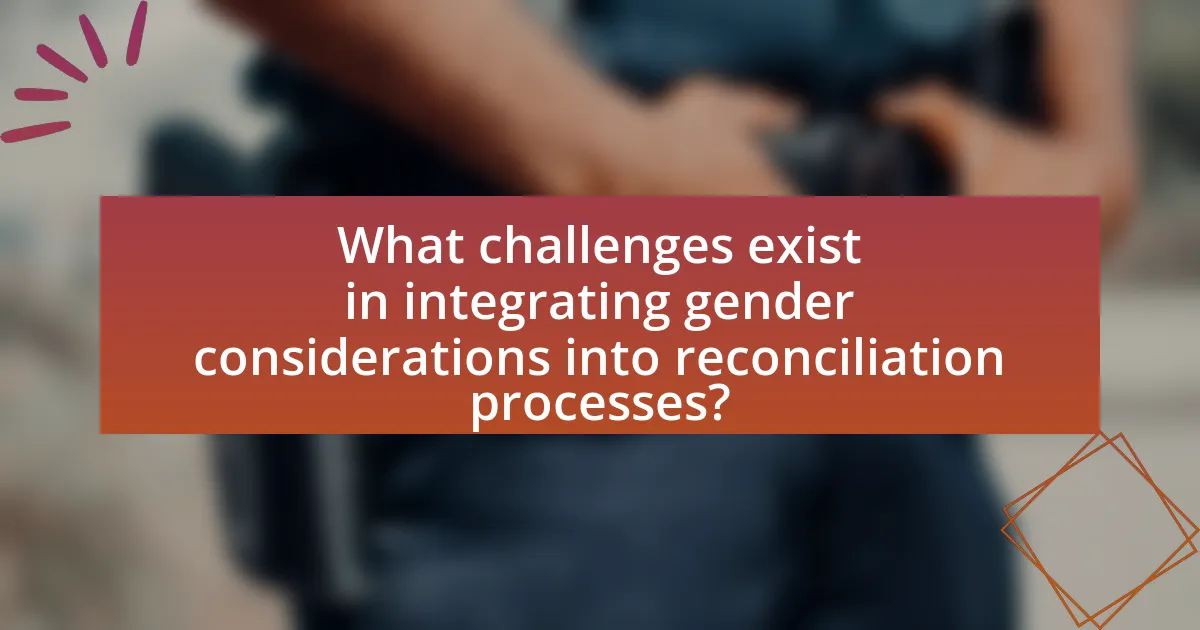
What challenges exist in integrating gender considerations into reconciliation processes?
Integrating gender considerations into reconciliation processes faces several challenges, including entrenched patriarchal norms, lack of representation, and insufficient understanding of gender-specific impacts of conflict. Patriarchal norms often marginalize women’s voices, leading to their exclusion from decision-making roles in reconciliation efforts. Additionally, the underrepresentation of women in peace negotiations and post-conflict governance limits the incorporation of gender perspectives. Research by the United Nations indicates that women’s participation in peace processes can significantly enhance the sustainability of peace agreements, yet women remain significantly underrepresented in these processes, with only 13% of negotiators being women in major peace talks from 1992 to 2019. Furthermore, there is often a lack of comprehensive data on the gendered impacts of conflict, which hinders the development of targeted strategies that address the specific needs of women and marginalized genders during reconciliation.
What barriers hinder the inclusion of gender perspectives in reconciliation?
Barriers that hinder the inclusion of gender perspectives in reconciliation include entrenched patriarchal norms, lack of political will, and insufficient representation of women in decision-making processes. Patriarchal norms often marginalize women’s voices and experiences, leading to their exclusion from reconciliation dialogues. Additionally, a lack of political will from leaders can result in inadequate support for gender-inclusive policies, as seen in various post-conflict societies where gender issues are deprioritized. Furthermore, insufficient representation of women in peace negotiations and reconciliation committees limits the integration of gender perspectives, as evidenced by the United Nations’ findings that women’s participation in peace processes is crucial for sustainable outcomes.
How do societal attitudes towards gender impact reconciliation efforts?
Societal attitudes towards gender significantly impact reconciliation efforts by influencing the inclusivity and effectiveness of these processes. When societies hold progressive views on gender equality, reconciliation initiatives are more likely to incorporate diverse perspectives, leading to comprehensive solutions that address the needs of all affected groups. For instance, research by the United Nations indicates that peace agreements are 35% more likely to last at least 15 years when women are included in the negotiation process. Conversely, societies with rigid gender norms may marginalize women’s voices, resulting in incomplete reconciliation that fails to address underlying grievances. This exclusion can perpetuate cycles of conflict and hinder long-term peacebuilding efforts.
What institutional challenges arise in addressing gender in these processes?
Institutional challenges in addressing gender in truth and reconciliation processes include inadequate representation of women, lack of gender-sensitive policies, and insufficient resources allocated for gender-focused initiatives. These challenges hinder the effective integration of gender perspectives, as evidenced by the United Nations’ findings that women’s participation in peace processes remains below 30%, which limits the diversity of voices and experiences considered in reconciliation efforts. Additionally, many institutions lack the training necessary to implement gender-sensitive approaches, resulting in a failure to address the specific needs and rights of women and marginalized genders in post-conflict settings.
What lessons can be learned from past reconciliation efforts regarding gender?
Past reconciliation efforts highlight the importance of integrating gender perspectives to ensure inclusive outcomes. For instance, the Truth and Reconciliation Commission in South Africa emphasized the need to address gender-based violence and the specific experiences of women during apartheid, which led to more comprehensive policies that recognized women’s roles in both conflict and peacebuilding. Additionally, studies show that when women participate in reconciliation processes, the likelihood of sustainable peace increases; the UN reports that peace agreements are 35% more likely to last at least 15 years when women are involved in the negotiation process. These examples illustrate that acknowledging and addressing gender issues is crucial for effective reconciliation.
What successful case studies highlight effective gender integration in reconciliation?
Successful case studies that highlight effective gender integration in reconciliation include the post-apartheid South Africa Truth and Reconciliation Commission (TRC) and the Colombian peace process. In South Africa, the TRC incorporated women’s testimonies and experiences, ensuring that gender-based violence was addressed, which led to a more inclusive narrative of the past. The commission’s final report emphasized the importance of women’s voices, resulting in policy changes that aimed to improve gender equality. In Colombia, the 2016 peace agreement included provisions for women’s participation in the peace process, recognizing their role in conflict resolution and community rebuilding. This agreement mandated the inclusion of women in decision-making bodies, which has led to increased representation and empowerment of women in post-conflict governance. Both cases demonstrate that integrating gender perspectives in reconciliation processes can lead to more comprehensive and sustainable outcomes.
How can failures in gender considerations inform future practices?
Failures in gender considerations can inform future practices by highlighting the need for inclusive frameworks that address the unique experiences of all genders. For instance, the lack of representation of women in peace negotiations has been shown to lead to less sustainable outcomes, as evidenced by the United Nations’ findings that peace agreements are 35% more likely to last at least 15 years when women are involved in the negotiation process. This data underscores the importance of integrating gender perspectives to enhance the effectiveness and longevity of reconciliation efforts. By analyzing past failures, stakeholders can develop strategies that ensure diverse voices are included, ultimately leading to more equitable and effective practices in truth and reconciliation processes.
What best practices can be adopted for gender considerations in reconciliation?
Best practices for gender considerations in reconciliation include ensuring women’s participation in decision-making processes, integrating gender-sensitive approaches in policy frameworks, and addressing gender-based violence as a critical component of reconciliation efforts. Women’s involvement in peace negotiations has been shown to lead to more sustainable outcomes; for instance, research by the United Nations indicates that peace agreements are 35% more likely to last at least 15 years when women are included in the negotiation process. Additionally, implementing gender-sensitive training for all stakeholders involved in reconciliation can enhance understanding and responsiveness to gender issues, thereby fostering a more inclusive environment. Addressing the specific needs and experiences of women and marginalized genders in post-conflict settings is essential for achieving equitable and lasting reconciliation.
How can stakeholders collaborate to promote gender inclusivity in reconciliation processes?
Stakeholders can collaborate to promote gender inclusivity in reconciliation processes by establishing inclusive frameworks that actively involve women and marginalized genders in decision-making roles. Research indicates that when women participate in peace processes, the likelihood of reaching lasting agreements increases by 35% (UN Women, 2015). This collaboration can be achieved through targeted outreach programs that engage diverse gender groups, ensuring their voices are heard and represented. Additionally, stakeholders can implement training programs that educate all participants about gender issues and the importance of inclusivity, fostering a culture of respect and equality. By integrating gender perspectives into all stages of reconciliation, stakeholders can create more equitable and effective outcomes.
What role does education play in fostering gender awareness in reconciliation efforts?
Education plays a crucial role in fostering gender awareness in reconciliation efforts by providing individuals with the knowledge and understanding necessary to recognize and address gender inequalities. Through educational programs, participants learn about the historical context of gender-based violence and discrimination, which is often exacerbated during conflicts. For instance, studies have shown that inclusive curricula that highlight women’s contributions and experiences in peacebuilding can lead to greater gender sensitivity among communities. Furthermore, education empowers marginalized voices, enabling women and gender minorities to actively participate in reconciliation processes, thereby promoting a more equitable and just society.



